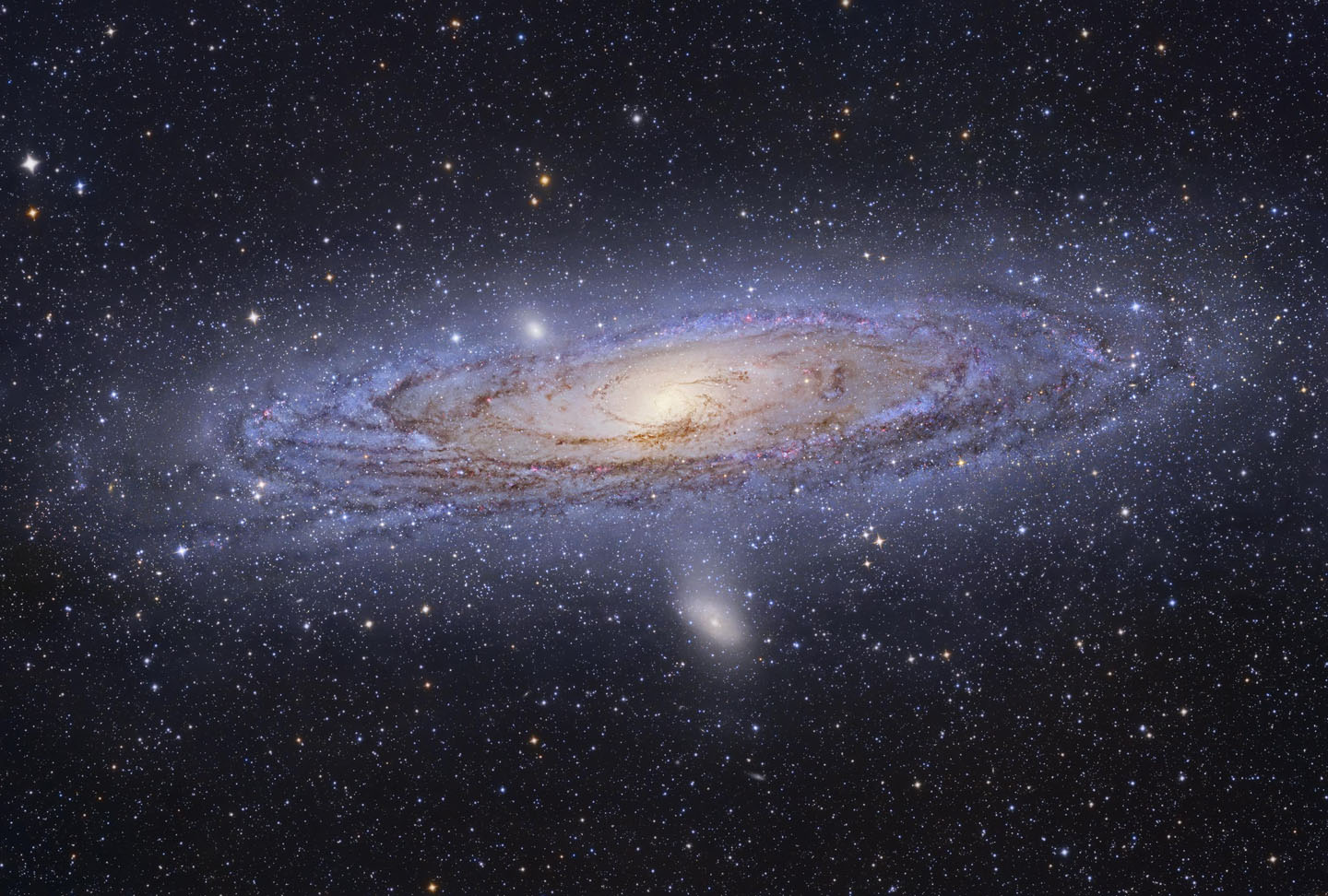







| BOOKS | F. A. Q. | ARTICLES | TALKS | ABOUT KEN | DONATE | BEYOND OUR KEN |
|---|
By Ken Croswell
Published on Astronomy.com (November 4, 2005).

Image by Tony and Daphne Hallas. Used by permission.
For the first time, an eclipsing binary has revealed the precise distance to the Andromeda Galaxy (M31), say astronomers in Spain, America, and Scotland. The distance is in excellent agreement with other, less direct determinations.
Andromeda is the largest and most luminous galaxy in the Local Group. Knowing its distance helps scientists determine the distances of more remote galaxies. In the past, astronomers have determined Andromeda's distance by observing its stars, notably its Cepheids and RR Lyraes, but deducing these stars' intrinsic brightnesses has depended on observations in other galaxies.
Now Ignasi Ribas of the Spanish Research Council (CSIC) and the Institute for Space Studies of Catalonia (IEEC) and his colleagues have determined Andromeda's distance directly, by observing a nineteenth magnitude eclipsing binary in one of the galaxy's spiral arms. The binary, known as M31VJ00443799+4129236, has two hot blue stars of spectral types O and B. As the stars orbit each other every 3.54969, they pass in front of and behind each other.
Astronomers have long used eclipsing binaries in the Milky Way to measure distances. The longer an eclipse lasts, the bigger the eclipsing star must be. The bigger and hotter the star, the more light it emits. Knowing each star's size and temperature therefore yields the pair's luminosity. Comparing the luminosity with the apparent brightness then reveals the system's distance.
 For 21 nights spread over four years, Ribas and his colleagues used the 2.5-meter Isaac Newton Telescope in the Canary Islands to observe the Andromeda binary's varying brightness at blue and yellow wavelengths. The astronomers also used the 8-meter Gemini North telescope in Hawaii to measure the stars' velocities, which vary as they orbit each other.
For 21 nights spread over four years, Ribas and his colleagues used the 2.5-meter Isaac Newton Telescope in the Canary Islands to observe the Andromeda binary's varying brightness at blue and yellow wavelengths. The astronomers also used the 8-meter Gemini North telescope in Hawaii to measure the stars' velocities, which vary as they orbit each other.
From these observations, the team determined the stars' properties. The O star has a temperature of 33,900 Kelvin, a mass 23 times the Sun's, and a diameter 13.1 times the Sun's. The B star's temperature is 27,700 Kelvin, its mass is 15 solar masses, and its diameter is 11.3 solar diameters. The stars' centers are 16.5 solar diameters apart, and the B star is spilling material onto the O star. Most importantly, the stars' absolute magnitudes are �5.29 and �4.66.
By comparing the absolute and apparent magnitudes, Ribas's team concluded the Andromeda Galaxy is 2.52 � 0.14 million light-years from Earth. This agrees perfectly with the Cepheid-based distance to Andromeda--2.5 million light-years--but unlike that distance does not depend on assuming a distance to the Large Magellanic Cloud. The agreement means astronomers can probably trust Cepheid distances to more distant galaxies, such as those in the Virgo and Fornax clusters.
Ribas and his colleagues plan to use other eclipsing binaries in Andromeda to further refine the galaxy's distance. They will publish their work in a future issue of Astrophysical Journal Letters.
Ken Croswell is a Harvard-trained astronomer and the author of Magnificent Universe and The Universe at Midnight.
"Elegant and eloquent"--Washington Post. See all reviews of Magnificent Universe here.
"The Universe at Midnight is vastly entertaining and enjoyable, as well as informative." --Patrick Moore, New Scientist. See all reviews of The Universe at Midnight here.
| BOOKS | F. A. Q. | ARTICLES | TALKS | ABOUT KEN | DONATE | BEYOND OUR KEN |
|---|